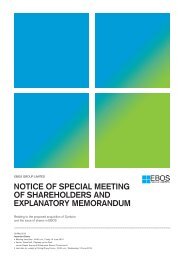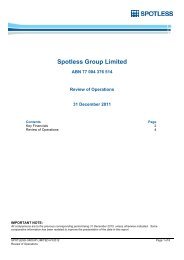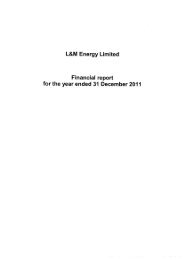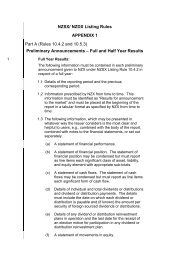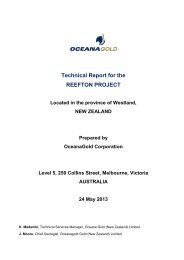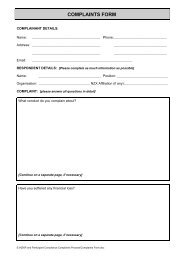Westpac Group Pillar 3 Report March 2013 - Iguana IR Sites
Westpac Group Pillar 3 Report March 2013 - Iguana IR Sites
Westpac Group Pillar 3 Report March 2013 - Iguana IR Sites
Create successful ePaper yourself
Turn your PDF publications into a flip-book with our unique Google optimized e-Paper software.
PILLAR 3 REPORT<br />
INTEREST RATE RISK IN THE BANKING BOOK (<strong>IR</strong>RBB)<br />
Interest Rate Risk in the Banking Book (<strong>IR</strong>RBB) is the risk to interest income arising from a mismatch between the<br />
duration of assets and liabilities that arises in the normal course of business activities.<br />
Approach<br />
The banking book activities that give rise to market risk include lending activities, balance sheet funding and<br />
capital management. Interest rate risk, currency risk and funding and liquidity risk are inherent in these activities.<br />
<strong>Group</strong> Treasury’s Asset & Liability Management (ALM) unit is responsible for managing market risk arising from<br />
<strong>Westpac</strong>’s banking book activity.<br />
All material regions, business lines and legal entities are included in <strong>Westpac</strong>’s <strong>IR</strong>RBB framework.<br />
Asset and liability management<br />
ALM manages the structural interest rate mismatch associated with the transfer priced balance sheet, including<br />
the investment of <strong>Westpac</strong>’s capital to its agreed benchmark duration. A key risk management objective is to<br />
achieve reasonable stability of Net Interest Income (NII) over time. These activities are performed under the<br />
oversight of MARCO and the Financial Markets & Treasury Risk (FMTR) unit.<br />
Net Interest Income sensitivity<br />
NII sensitivity is managed in terms of the net interest income-at-risk (NaR) modelled over a three year time horizon<br />
to a 99% confidence interval for movements in wholesale market interest rates. A simulation model is used to<br />
calculate <strong>Westpac</strong>’s potential NaR. The NII simulation framework combines the underlying statement of financial<br />
position data with assumptions about runoff and new business, expected repricing behaviour and changes in<br />
wholesale market interest rates. Simulations using a range of interest rate scenarios are used to provide a series<br />
of potential future NII outcomes. The interest rate scenarios modelled include those projected using historical<br />
market interest rate volatility as well as 100 and 200 basis point shifts up and down from current market yield<br />
curves. Additional stressed interest rate scenarios are also considered and modelled.<br />
A comparison between the NII outcomes from these modelled scenarios indicates the sensitivity to interest rate<br />
changes. On and off-balance sheet instruments are then used to manage this interest rate risk.<br />
NaR limit<br />
The BRMC has approved a NaR limit. This limit is managed by the Treasurer and is expressed as a deviation from<br />
benchmark hedge levels over a one-year rolling time frame, to a 99% level of confidence. This limit is monitored by<br />
FMTR.<br />
VaR limit<br />
The BRMC has also approved a VaR limit for ALM activities. This limit is managed by the Treasurer and monitored<br />
by FMTR. Additionally, FMTR sets structural risk limits to prevent undue concentration of risk.<br />
Structural foreign exchange rate risk<br />
Structural foreign exchange rate risk results from the generation of foreign currency denominated earnings and<br />
from <strong>Westpac</strong>'s capital deployed in offshore branches and subsidiaries, where it is denominated in currencies<br />
other than Australian dollars. The Australian dollar equivalent of offshore earnings and capital is subject to change<br />
as exchange rates fluctuate, which could introduce significant variability to <strong>Westpac</strong>'s reported financial results.<br />
ALCO provides oversight of the appropriateness of foreign exchange hedges on earnings.<br />
Risk reporting<br />
Interest rate risk in the banking book risk measurement systems and personnel are located in Sydney, Auckland,<br />
Singapore and Shanghai. These include front office product systems, which capture all treasury funding and<br />
derivative transactions; the transfer pricing system, which captures all retail and other business transactions; nontraded<br />
VaR systems, which calculate <strong>Group</strong> Treasury VaR; and, the NII system, which calculates NaR.<br />
Daily monitoring of current exposure and limit utilisation is conducted independently by FMTR, which monitors<br />
market risk exposures against VaR, NaR and structural risk limits. Management reports detailing structural<br />
positions and VaR are produced and distributed daily for use by dealers and management across all stakeholder<br />
groups. Monthly and quarterly reports are produced for the senior management market risk forums of MARCO and<br />
BRMC respectively to provide transparency of material market risks and issues.<br />
74



